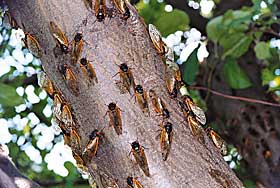  |
| HOME | THIS ISSUE | CALENDAR | GRANTS | BACK ISSUES | < BACK | NEXT > |
UConn scientists map mass emergence of cicadas in Midwestby Cindy Weiss - June 18, 2007 | ||||
| A team of biologists from the College of Liberal Arts and Sciences descended on northern Illinois a couple of weeks ago to map the mass emergence of millions of 17-year cicadas. This is the first time that GPS (Global Positioning Systems) has been used in combination with computerized data entry to accurately track the spectacle of a brood of periodical cicadas emerging. Chris Simon, professor of ecology and evolutionary biology, is a leading expert on periodical cicadas. A team of researchers from her laboratory, led by research associate John Cooley, is mapping the emergence of “Brood XIII” of the insects in the Midwest for the National Geographic Society. Brood XIII is found from the northern half of Illinois to Iowa, Indiana, Michigan, and Wisconsin. The cicadas in this emergence hatched in 1990, when their parents came up from underground. On one of the first days of the Brood XIII’s emergence, more than 100,000 cicadas surrounded a single tree in a forest preserve in suburban Chicago, Cooley told the Chicago Tribune. Periodical cicada broods usually take about two weeks to emerge, depending on temperatures. The periodicals, which differ from the less numerous, shorter-lived annual cicadas, live underground as nymphs for 17 or 13 years. There they feed on the roots of plants. When they come out, they finish maturing, mate, lay eggs in the twigs of trees, and die, leaving a litter of shells behind. The eggs hatch, the nymphs fall to the ground, and the cycle begins again. During their brief time above ground, they dominate the landscape. They coat the trees, and their shells coat the ground. Their synchronized, dawn-to-dusk buzz (a common sound effect in horror movies) is so loud that biologists counting them often wear ear protection. The sight and sound of the periodicals was eagerly awaited by the Simon lab research team. They packed their cars with tents, GPS units, and collection supplies, and waited for the first reports of the insects showing up in late May and early June. The maps they make will help biologists understand more about the range of this species, where it will re-emerge in 2024, and how its distribution is affected by other broods that emerge in different years. Simon, who receives research funding from the National Science Foundation, is interested in the DNA of the periodical cicadas, their evolutionary tree, and how new species form. Two members of her research team, Cooley and David Marshall, have studied the songs of cicadas to help differentiate new species.
Some of the 17-year cicadas in the Midwest, a periodical cicada stronghold, switched back to a 13-year cycle and joined existing 13-year cicada groups. The life-cycle- switching cicadas formed a new 13-year species that did not interbreed with the existing 13-year cicadas. “We found these new 13-year cicadas through DNA studies. Based on the DNA, I could tell they weren’t interbreeding (with the existing 13-year cicadas), but I didn’t know why,” she says. Cooley and Marshall came from the University of Michigan to work as postdoctoral fellows with Simon at UConn. Their behavioral work complemented her genetic studies, showing that cicadas sought mates among those whose songs matched their own. In fact, in areas where the new and old 13-year cicadas overlapped, natural selection caused the new 13-year cicadas to pitch their mating song higher to enhance its difference. This phenomenon, predicted by evolutionary theory, is “reproductive character displacement,” Simon says. Simon’s group maintains a web site well known to cicada experts, Cicada Central, which was cited in the Chicago Tribune’s daily updates of the recent emergence, and a blog detailing their findings. Other members of her group traveling to the Midwest were technician Kathy Hill, graduate student Beth Jacobsen, and Gerry Bunker, an amateur enthusiast from Massachusetts. Periodical cicadas once existed near the University’s Storrs campus. The extinction of a brood in Willington was confirmed years ago by James Slater, emeritus professor of biology; Carl Schaeffer, professor of ecology and evolutionary biology; and others. The only other Connecticut brood occurs in the Connecticut River Valley and is not due out until 2013, Simon says. But stay tuned. In 2008, Brood XIV is due to come out over much of the eastern U.S., from Maryland to Cape Cod (skipping Connecticut), from Long Island to Ohio, and as far south as Tennessee. |
| ADVANCE HOME UCONN HOME |

